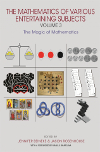- About MAA
- Membership
- MAA Publications
- Periodicals
- Blogs
- MAA Book Series
- MAA Press (an imprint of the AMS)
- MAA Notes
- MAA Reviews
- Mathematical Communication
- Information for Libraries
- Author Resources
- Advertise with MAA
- Meetings
- Competitions
- Programs
- Communities
- MAA Sections
- SIGMAA
- MAA Connect
- Students
- MAA Awards
- Awards Booklets
- Writing Awards
- Teaching Awards
- Service Awards
- Research Awards
- Lecture Awards
- Putnam Competition Individual and Team Winners
- D. E. Shaw Group AMC 8 Awards & Certificates
- Maryam Mirzakhani AMC 10 A Awards & Certificates
- Two Sigma AMC 10 B Awards & Certificates
- Jane Street AMC 12 A Awards & Certificates
- Akamai AMC 12 B Awards & Certificates
- High School Teachers
- News
You are here
The Mathematics of Various Entertaining Subjects, Volume 3

Publisher:
Princeton University Press
Publication Date:
2019
Number of Pages:
352
Format:
Paperback
Price:
49.95
ISBN:
9780691194417
Category:
Collection
The Basic Library List Committee suggests that undergraduate mathematics libraries consider this book for acquisition.
[Reviewed by , on ]
Tom French
09/8/2019
Beineke and Rosenhouse have assembled an impressive array of contributors for the third volume in their series on recreational mathematics. This is my first exposure to the series. My initial observation is: “this is NOT your father’s book on mathematical amusements”. The editors present a sophisticated array of mathematic and logic puzzlers. Solutions are presented for each of the problems. Some of the problems are quite straight forward and are readily solvable by those with limited mathematics training. However, many of the problems and solutions are robust and challenging. It may well require an upper-level undergraduate to fully understand and appreciate these problems and solutions.
The text is sectioned into four parts: I) Puzzles & Brainteasers, II) Games, III) Algebra & Number Theory, and IV) Geometry & Topology. Each of these sections, in turn consists of three to five chapters, each of which is written by a different author(s). I found myself skipping around between sections or chapters and tackling problems that captured my interest at the moment.
The collection of problems presented by the editors go far deeper than “the ordinary puzzle”. For example, Chapter 15 begins by introducing us to the KenKen puzzle, which is a complex form of a Sudoku-type puzzle. We are presented a straightforward KenKen to solve. As Chapter 15 unfolds, we are asked to consider if the solution is unique. The remainder of Chapter 15 is a highly structured mathematical proof of how to classify puzzles by their number of solutions. The mathematics goes well beyond what most would consider recreational mathematics and enters the realm of pure mathematics complete with its formal theorems and lemmas.
I also found myself drawn to Chapter 5 which examines strategies on “How to Predict the Flip of a Coin.” The authors demonstrate techniques which allows one to predict the outcome of a coin flip more than 50% of the time. The authors show several experiments for making such a prediction. One such experiment develops a technique using what the authors term as a “Compound Bernoulli Trial” which is a two-stage Bernoulli Trial consisting of two independent experiments conducted in sequence. Their conclusions seem to predict that, using this technique, one may be able to correctly predict the outcome of a coin flip more than half the time.
Whether your interests lie in graph theory, magic card tricks, bingo games, or Lego plates, you will find something of interest for yourself in this book. In addition to the mathematical recreations, you will find a deep and hidden connection to pure (or is it applied?) mathematics. This book is a welcome addition to my library. The wide range of problems presented in this text can be useful for both the college professor as well as high school teacher who is looking for challenging problems to present to their students. Those interested in recreational mathematics will find unique problems not ordinarily found in such texts. And those who love to dabble and study a large variety of entertaining mathematical topics will find a treasure trove of topics which will keep them busy on many a cold winter’s night while studying by the fire.
Tom French has a B.S. and M.S. degree in Mathematics from Minnesota State University, Mankato. He has 35 years of engineering and business experience with UNIVAC and its successor companies. He was part of the design team that first implemented medium-scale and large-scale integrated circuits into computers. Tom was the program manager for several large product innovations and was one of the leaders who implemented the technology revolution into the banking system in the Russian Federation. He has lectured on mathematics and computer systems throughout the world and has taught mathematics at a number of US colleges and universities.
The table of contents is not available.
- Log in to post comments




